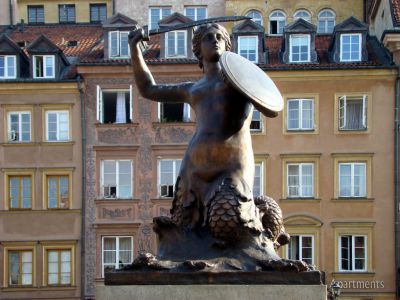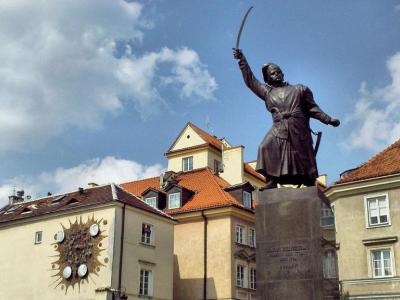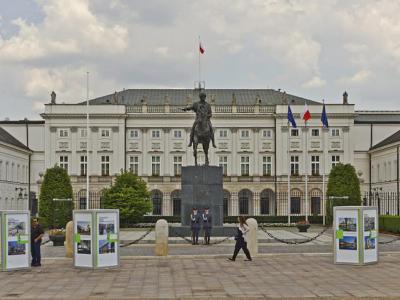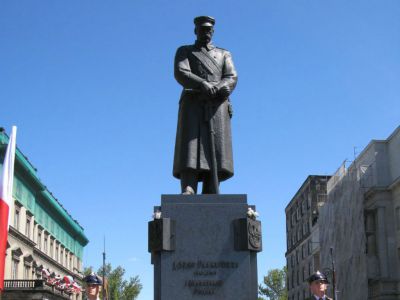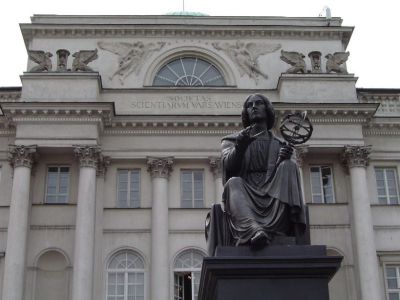
Monuments and Statues (Self Guided), Warsaw
The capital city of a proud nation such as Poland, Warsaw is abundant with monuments of various sorts, dedicated to celebrated personalities and those who made a mark in the history of the country.
Some of these landmarks serve as reminders of the city's resilience and the enduring spirit of its people. Among them are the Jan Kiliński Monument commemorating a hero of the 1794 Kosciuszko Uprising against foreign occupation, and the so-called Nike, or the Monument of Warsaw's Heroes (Pomnik Bohaterów Warszawy), paying tribute to the valiant fighters who defended Warsaw during World War II.
Another solemn tribute to those who gave their lives for Poland is the Tomb of the Unknown Soldier – a place of reflection and national remembrance.
Standing proudly throughout the city are also monuments to distinguished military leaders like Prince Józef Poniatowski and the renowned statesman Józef Piłsudski who played a vital role in the rebirth of Poland as an independent nation after World War I.
Right behind the Poniatowski Monument is the Presidential Palace. An architectural marvel in its own right, it serves as the official residence of the President of Poland, underscoring its historical importance.
The Adam Mickiewicz Monument, dedicated to one of the country's greatest poets, is located near the Church of the Assumption of the Blessed Virgin Mary (Kościół Seminaryjny), and is a place of cultural significance and poetic inspiration. Meanwhile, the Nicolaus Copernicus Monument commemorates the legendary astronomer and mathematician, emphasizing Poland's contributions to science and knowledge.
Still, one of the most iconic statues in Warsaw is the Mermaid, otherwise known as Syrenka in Polish. This mythical creature, wielding a sword and a shield, is the city's symbol and represents its strong connection to the Vistula River.
As you explore Warsaw's monuments and statues, you can't help feeling their beckoning you with the deep-rooted history underlying each one of them. So, take a stroll through the city's streets, visit these iconic sites, and learn more about the indomitable spirit of Warsaw.
Some of these landmarks serve as reminders of the city's resilience and the enduring spirit of its people. Among them are the Jan Kiliński Monument commemorating a hero of the 1794 Kosciuszko Uprising against foreign occupation, and the so-called Nike, or the Monument of Warsaw's Heroes (Pomnik Bohaterów Warszawy), paying tribute to the valiant fighters who defended Warsaw during World War II.
Another solemn tribute to those who gave their lives for Poland is the Tomb of the Unknown Soldier – a place of reflection and national remembrance.
Standing proudly throughout the city are also monuments to distinguished military leaders like Prince Józef Poniatowski and the renowned statesman Józef Piłsudski who played a vital role in the rebirth of Poland as an independent nation after World War I.
Right behind the Poniatowski Monument is the Presidential Palace. An architectural marvel in its own right, it serves as the official residence of the President of Poland, underscoring its historical importance.
The Adam Mickiewicz Monument, dedicated to one of the country's greatest poets, is located near the Church of the Assumption of the Blessed Virgin Mary (Kościół Seminaryjny), and is a place of cultural significance and poetic inspiration. Meanwhile, the Nicolaus Copernicus Monument commemorates the legendary astronomer and mathematician, emphasizing Poland's contributions to science and knowledge.
Still, one of the most iconic statues in Warsaw is the Mermaid, otherwise known as Syrenka in Polish. This mythical creature, wielding a sword and a shield, is the city's symbol and represents its strong connection to the Vistula River.
As you explore Warsaw's monuments and statues, you can't help feeling their beckoning you with the deep-rooted history underlying each one of them. So, take a stroll through the city's streets, visit these iconic sites, and learn more about the indomitable spirit of Warsaw.
How it works: Download the app "GPSmyCity: Walks in 1K+ Cities" from Apple App Store or Google Play Store to your mobile phone or tablet. The app turns your mobile device into a personal tour guide and its built-in GPS navigation functions guide you from one tour stop to next. The app works offline, so no data plan is needed when traveling abroad.
Monuments and Statues Map
Guide Name: Monuments and Statues
Guide Location: Poland » Warsaw (See other walking tours in Warsaw)
Guide Type: Self-guided Walking Tour (Sightseeing)
# of Attractions: 10
Tour Duration: 2 Hour(s)
Travel Distance: 2.9 Km or 1.8 Miles
Author: leticia
Sight(s) Featured in This Guide:
Guide Location: Poland » Warsaw (See other walking tours in Warsaw)
Guide Type: Self-guided Walking Tour (Sightseeing)
# of Attractions: 10
Tour Duration: 2 Hour(s)
Travel Distance: 2.9 Km or 1.8 Miles
Author: leticia
Sight(s) Featured in This Guide:
- The Mermaid
- Jan Kiliński Monument
- Nike (Pomnik Bohaterów Warszawy)
- Adam Mickiewicz Monument
- Monument to Adam Mickiewicz and Kościół Seminaryjny (Seminary Church)
- Poniatowski Monument
- Presidential Palace
- Józef Piłsudski Monument
- Tomb of the Unknown Soldier
- Nicolaus Copernicus Monument
1) The Mermaid
The Baltic Sea was home to two mermaids once upon a time. These half-women, half-fish sisters eventually got bored of their aquatic life. Their decision to come to the shore led the first sister to the Danish Straits. She settled at the Port of Copenhagen entrance. The other sister reached the port of Gdansk and then swam across the river Vistula right to the end. She finally rested on a sandy bank at the foot of Old Town in Warsaw.
When the fishermen here found that someone was letting their hard caught fishes go, they were furious and decided to punish the culprit. When they found that it was none other than the mermaid, they decided to let her stay. For their generosity, the villagers were entertained by the mermaid every evening with lilting songs.
When a rich merchant decided to make money showcasing here at a fair, he captured her and kept her in a wooden shed. A village lad heard her cries and set her free with the help of his friends. In gratitude, the mermaid promised to defend the village which later grew into the city of Warsaw.
Today, the mermaid stands in defense wielding a sword and carrying a shield. She continues to protect the city of Warsaw. Enjoy a visit to the mermaid’s statue at the Old Town.
When the fishermen here found that someone was letting their hard caught fishes go, they were furious and decided to punish the culprit. When they found that it was none other than the mermaid, they decided to let her stay. For their generosity, the villagers were entertained by the mermaid every evening with lilting songs.
When a rich merchant decided to make money showcasing here at a fair, he captured her and kept her in a wooden shed. A village lad heard her cries and set her free with the help of his friends. In gratitude, the mermaid promised to defend the village which later grew into the city of Warsaw.
Today, the mermaid stands in defense wielding a sword and carrying a shield. She continues to protect the city of Warsaw. Enjoy a visit to the mermaid’s statue at the Old Town.
2) Jan Kiliński Monument
Jan Kilinski is another monument dedicated to a 1794 Warsaw Uprising hero. This monument commemorates a humble shoemaker who fought bravely during the Uprising. As he fought hard to defend his beloved city, he was wounded twice. For several years afterwards, the shoemaker was imprisoned in Saint Petersburg.
Col. Tadeusz Kociuszko nominated him for the honor of being commemorated through a monument. Stanislaw Jackowski erected the Jan Kilinski Monument in honor of this hero in the year 1936. The statue was removed from Krasinski Square by the Germans during World War II and taken to the National Gallery. Germans were retaliating for the removal of a German plaque from Copernicus’ statue.
Grey Squad resistance fighters discovered the statue following which the walls of the museum screamed with inscriptions that said People of Warsaw! I am here, Kilinski. It was in 1959, after the end of the war that the monument was finally moved to Podwale Street, its original place.
Jan Kilinski monument is certainly a must visit on your trip to Warsaw. Tourists come here to pay respects to this most unlikely hero of the Warsaw Uprising. There are many monuments in Warsaw and this one is definitely the most popular among them.
Col. Tadeusz Kociuszko nominated him for the honor of being commemorated through a monument. Stanislaw Jackowski erected the Jan Kilinski Monument in honor of this hero in the year 1936. The statue was removed from Krasinski Square by the Germans during World War II and taken to the National Gallery. Germans were retaliating for the removal of a German plaque from Copernicus’ statue.
Grey Squad resistance fighters discovered the statue following which the walls of the museum screamed with inscriptions that said People of Warsaw! I am here, Kilinski. It was in 1959, after the end of the war that the monument was finally moved to Podwale Street, its original place.
Jan Kilinski monument is certainly a must visit on your trip to Warsaw. Tourists come here to pay respects to this most unlikely hero of the Warsaw Uprising. There are many monuments in Warsaw and this one is definitely the most popular among them.
3) Nike (Pomnik Bohaterów Warszawy)
The Monument to the Heroes of Warsaw, also known as the Warsaw Nike was built to commemorate those who fought bravely during World War II to obtain freedom for the city.
Many of the heroes who fought during the 1944 Warsaw Uprising are specially remembered here. This uprising saw many minor victories for the city. People fought hard and liberated parts of Warsaw from the Nazis.
Though the uprising was defeated due to the lack of any help from outside, it is remembered for its many heroes. At this monument you can find Nike, the Greek Goddess of Victory. She wields a sword and stands all of five meters tall. The statue is made of iron and stands on a sandstone pedestal. The statue looks huge and majestic and dominates the entire area.
First erected in the year 1964, the Warsaw Nike Monument became very popular in due course of time. People gather here in large numbers to pay homage to the courageous heroes. This monument is located at Theatre Square or Plac Teatralny and was renovated on a large scale in 1999.
Do not miss a visit to this unique and interesting monument located close to some of the major tourist attractions in Warsaw like the Presidential Palace, the Royal Castle and the Old Town Square.
Many of the heroes who fought during the 1944 Warsaw Uprising are specially remembered here. This uprising saw many minor victories for the city. People fought hard and liberated parts of Warsaw from the Nazis.
Though the uprising was defeated due to the lack of any help from outside, it is remembered for its many heroes. At this monument you can find Nike, the Greek Goddess of Victory. She wields a sword and stands all of five meters tall. The statue is made of iron and stands on a sandstone pedestal. The statue looks huge and majestic and dominates the entire area.
First erected in the year 1964, the Warsaw Nike Monument became very popular in due course of time. People gather here in large numbers to pay homage to the courageous heroes. This monument is located at Theatre Square or Plac Teatralny and was renovated on a large scale in 1999.
Do not miss a visit to this unique and interesting monument located close to some of the major tourist attractions in Warsaw like the Presidential Palace, the Royal Castle and the Old Town Square.
4) Adam Mickiewicz Monument
Adam Mickiewicz Monument commemorates one of the most popular Romantic poets of Poland. This monument was unveiled on Adam Mickiewicz’s 100th birthday in 1898. The sculpture was created by Cyprian Godebski, a renowned sculptor.
It was at this monument that Poles protested the removal of ‘Dziady”, one of Mickiewicz’s works from the list of national theatre performances in March 1968. This monument is a very popular tourist spot and is located close to Skwer Hoovera where many exhibitions and concerts are held and also near the Church of the Assumption of Saint Joseph and Virgin Mary.
When the Warsaw Uprising fell in 1944, the Adam Mickiewicz monument was destroyed by the Nazi Germans. Parts that remained of the destroyed monument were transported to Germany. When the war ended, head and many other parts of the original statue were found by the Polish soldiers in Hamburg.
The exact replica of the original statue was sculpted by sculptor Jan Szczepkowski. All parts of the monument, including its environs were reconstructed and restored exactly as it was originally. This version of the monument was unveiled on January 28th, 1950. It was only in the 1980s that Poland got back the remaining parts of the monument.
It was at this monument that Poles protested the removal of ‘Dziady”, one of Mickiewicz’s works from the list of national theatre performances in March 1968. This monument is a very popular tourist spot and is located close to Skwer Hoovera where many exhibitions and concerts are held and also near the Church of the Assumption of Saint Joseph and Virgin Mary.
When the Warsaw Uprising fell in 1944, the Adam Mickiewicz monument was destroyed by the Nazi Germans. Parts that remained of the destroyed monument were transported to Germany. When the war ended, head and many other parts of the original statue were found by the Polish soldiers in Hamburg.
The exact replica of the original statue was sculpted by sculptor Jan Szczepkowski. All parts of the monument, including its environs were reconstructed and restored exactly as it was originally. This version of the monument was unveiled on January 28th, 1950. It was only in the 1980s that Poland got back the remaining parts of the monument.
5) Monument to Adam Mickiewicz and Kościół Seminaryjny (Seminary Church)
Seminary Church (Kościół Seminaryjny) is a religious edifice dedicated to the Assumption of the Virgin Mary and Saint Joseph, constructed in the Baroque style between 1661 and 1681, with its design attributed to J. Belottiego. It is commonly referred to as the Carmelite Church and serves as a Roman Catholic place of worship. Notably, the Carmelite Church boasts a prominent Neoclassical-style facade, which was added between 1761 and 1783. The church took on its current appearance during the 17th century and is particularly renowned for its twin bell towers, resembling censers.
Construction of the church began in 1661, and it was completed between 1692 and 1701 by architect Józef Szymon Bellotti. The impressive facade, added in 1761 by Prince Karol Stanisław Radziwiłł and architect Efraim Szreger, features prominent columns. Renowned artist Szymon Czechowicz contributed paintings, while Franciszek Smuglewicz created altar paintings. Inside, the church boasts a magnificent rococo main altar, lavish gilding, and ornate stucco ceiling decorations. The church played a role in Frédéric Chopin's early career, as he gave a recital on its organ.
Near the Church of the Assumption of the Virgin Mary stands the Adam Mickiewicz Monument, dedicated to one of Poland's most celebrated poets. This monument holds cultural significance and serves as a source of poetic inspiration.
The monument was erected on the site of demolished buildings in 1865 and was sculpted by Godebski in Italy starting in 1897. The 4.2-meter-tall bronze statue was cast in Pistoia, Italy, and the red granite column and foundations were produced by an Italian company near Milan.
The statue depicts Adam Mickiewicz in a dignified pose, with his head slightly raised and his right hand placed over his heart. The unveiling ceremony took place on December 24, 1898, in a subdued manner, as the authorities feared it might become a symbol of Polish aspirations for independence. Consequently, all marches and speeches were banned, and the monument was unveiled in silence before an audience of 12,000 people.
Construction of the church began in 1661, and it was completed between 1692 and 1701 by architect Józef Szymon Bellotti. The impressive facade, added in 1761 by Prince Karol Stanisław Radziwiłł and architect Efraim Szreger, features prominent columns. Renowned artist Szymon Czechowicz contributed paintings, while Franciszek Smuglewicz created altar paintings. Inside, the church boasts a magnificent rococo main altar, lavish gilding, and ornate stucco ceiling decorations. The church played a role in Frédéric Chopin's early career, as he gave a recital on its organ.
Near the Church of the Assumption of the Virgin Mary stands the Adam Mickiewicz Monument, dedicated to one of Poland's most celebrated poets. This monument holds cultural significance and serves as a source of poetic inspiration.
The monument was erected on the site of demolished buildings in 1865 and was sculpted by Godebski in Italy starting in 1897. The 4.2-meter-tall bronze statue was cast in Pistoia, Italy, and the red granite column and foundations were produced by an Italian company near Milan.
The statue depicts Adam Mickiewicz in a dignified pose, with his head slightly raised and his right hand placed over his heart. The unveiling ceremony took place on December 24, 1898, in a subdued manner, as the authorities feared it might become a symbol of Polish aspirations for independence. Consequently, all marches and speeches were banned, and the monument was unveiled in silence before an audience of 12,000 people.
6) Poniatowski Monument
Poniatowski Monument was constructed in commemoration of a Warsaw Military commander Prince Poniatowski. He was also the French Marshall and war minister. The statue of this prince is modeled after Roman Capitol’s Caesar Marc Aurelius.
Also known as Prince Jozef, this aristocrat was brought up in Vienna and Prague. He however chose Poland as his country and displayed his patriotism towards his origins. The statue in this monument was sculpted by Bartel Thorvaldsen. It is located right in front of Palac Prezydencki, the Presidential Palace.
There was a prolonged search for a permanent site for this monument. Its display was banned through a Tsar’s special order. It was shipped to Modlin forts and from here to Ivan Paszkiewicz’s Belarussian residence. He was a trusted general of the Tsar. It was only in 1922 that the statue was returned to Poland and placed on the Royal Castle grounds.
The following year, it was moved to Saski Palace grounds. During World War II, Poniatowski’s statue was demolished by the Nazis. In the early 1950s, a copy of the statue from the Copenhagen Museum was used to make a new cast which was poured and presented to Poland by Denmark’s King. Today the monument is visited by tourists from across the world.
Also known as Prince Jozef, this aristocrat was brought up in Vienna and Prague. He however chose Poland as his country and displayed his patriotism towards his origins. The statue in this monument was sculpted by Bartel Thorvaldsen. It is located right in front of Palac Prezydencki, the Presidential Palace.
There was a prolonged search for a permanent site for this monument. Its display was banned through a Tsar’s special order. It was shipped to Modlin forts and from here to Ivan Paszkiewicz’s Belarussian residence. He was a trusted general of the Tsar. It was only in 1922 that the statue was returned to Poland and placed on the Royal Castle grounds.
The following year, it was moved to Saski Palace grounds. During World War II, Poniatowski’s statue was demolished by the Nazis. In the early 1950s, a copy of the statue from the Copenhagen Museum was used to make a new cast which was poured and presented to Poland by Denmark’s King. Today the monument is visited by tourists from across the world.
7) Presidential Palace
Home to the Polish head of state, the Presidential Palace was built in 1643 as a home for local aristocrat Crown Great Hetman Stanislaw Koniecpolski. Koniecpolski owned so much of eastern Poland that he could cross the Commonwealth and spend each night in one of his own manors. The palace was designed by architect Constantino Tencalla, who also designed Sigismund's Column in Castle Square.
It's had several refurbishments since then. The current neoclassical style has been in place since 1818. Ever since then, it has served various government functions.
The first historical events occurred even earlier, though. In 1791, the home hosted the authors of the Constitution of May 3, 1791. That constitution was the first of its kind in Europe and the second of its kind in the world. In 1818, the house became the seat of the Viceroy. The council of ministers sat here between World Wars I and II. Since the German occupiers used the house, it survived World War II intact. After the war, the Warsaw Pact between the Soviet Union and the Eastern Bloc countries was signed here.
Since 1994, the palace has been the seat of the President of the Republic of Poland. As this is a functioning government building, visitors are not allowed inside, and the building is heavily guarded. But you can admire the impressive neoclassical facade from Nowy Street.
You'll also notice the large equestrian statue of Prince Jozef Poniatowski, created by Danish artist Bertel Thorvaldsen. The statue is modeled after a similar one of Roman Emperor Marcus Aurelius from Capitoline Hill in Rome. The original statue was destroyed during the Nazi occupation of Poland, and this recreation was made in 1950. It was based on Thorvaldsen's original models, donated from the Thorvaldsen Museum in Copenhagen.
It's had several refurbishments since then. The current neoclassical style has been in place since 1818. Ever since then, it has served various government functions.
The first historical events occurred even earlier, though. In 1791, the home hosted the authors of the Constitution of May 3, 1791. That constitution was the first of its kind in Europe and the second of its kind in the world. In 1818, the house became the seat of the Viceroy. The council of ministers sat here between World Wars I and II. Since the German occupiers used the house, it survived World War II intact. After the war, the Warsaw Pact between the Soviet Union and the Eastern Bloc countries was signed here.
Since 1994, the palace has been the seat of the President of the Republic of Poland. As this is a functioning government building, visitors are not allowed inside, and the building is heavily guarded. But you can admire the impressive neoclassical facade from Nowy Street.
You'll also notice the large equestrian statue of Prince Jozef Poniatowski, created by Danish artist Bertel Thorvaldsen. The statue is modeled after a similar one of Roman Emperor Marcus Aurelius from Capitoline Hill in Rome. The original statue was destroyed during the Nazi occupation of Poland, and this recreation was made in 1950. It was based on Thorvaldsen's original models, donated from the Thorvaldsen Museum in Copenhagen.
8) Józef Piłsudski Monument
Jozef Pilsudski was a supreme Polish Army commander, twice Polish Prime Minister, the first marshal and head of the Polish State. Jozef Pilsudski Monument commemorates this popular public figure. The monument was unveiled in August 1995 and designed by a famous Polish sculptor Tadeusz Lodzian.
The statue was cast in Gydnia’s Navy shipyard and for years, there was contemplation and discussions on where to place it. Originally, it was to be placed at Na Rozdrozu Square. Another proposed location was at the Lazienki Park gate. Committee that took responsibility to create the monument strongly put across their proposal to place it in Pilsudskiego Square.
Some felt that it should be moved to a Gdynia pier and place Stanislaw Ostrowski’s monument in the Square. Finally, Jozef Pilsudski Monument found a place at Belvedere in Pilsudskiego Square in front of the Tomb of the Unknown.
This interesting monument is a popular tourist spot frequented by visitors through the year. There are a total of two statues of Pilsudski in Warsaw and this is one of them. The other one is located at the Belvedere Palace.
As Pilsudski statue fondly looks down on the cars parked in front of him, Varsovians affectionately refer to him as the “father of the parking lot”.
The statue was cast in Gydnia’s Navy shipyard and for years, there was contemplation and discussions on where to place it. Originally, it was to be placed at Na Rozdrozu Square. Another proposed location was at the Lazienki Park gate. Committee that took responsibility to create the monument strongly put across their proposal to place it in Pilsudskiego Square.
Some felt that it should be moved to a Gdynia pier and place Stanislaw Ostrowski’s monument in the Square. Finally, Jozef Pilsudski Monument found a place at Belvedere in Pilsudskiego Square in front of the Tomb of the Unknown.
This interesting monument is a popular tourist spot frequented by visitors through the year. There are a total of two statues of Pilsudski in Warsaw and this is one of them. The other one is located at the Belvedere Palace.
As Pilsudski statue fondly looks down on the cars parked in front of him, Varsovians affectionately refer to him as the “father of the parking lot”.
9) Tomb of the Unknown Soldier
The Tomb of the Unknown Soldier in Warsaw, located at Piłsudski Square, holds significant historical and symbolic value, especially as the sole remnant of the once-grand Saxon Palace that was destroyed during World War II.
The tomb, dedicated on 2 November 1925, houses the remains of an unidentified young soldier who perished in the Defence of Lwów. This act of remembrance extends beyond this single soldier; the tomb also contains urns filled with soil from various battlefields where Polish soldiers bravely fought, intertwining the memory of numerous unheralded heroes within its structure.
A defining feature of the Tomb is the eternal flame that burns perpetually, symbolizing the enduring memory and respect for the fallen soldiers. The flame is complemented by a permanent guard post, manned by the Representative Company of the Polish Army, further underscoring the nation's homage to its military sacrifices.
The Tomb of the Unknown Soldier in Warsaw is not just a memorial but also a focal point for military commemorations in Poland. It is here that most official military ceremonies are conducted, and it serves as a place of respect where foreign dignitaries lay wreaths during their visits to Poland, paying homage to the brave soldiers.
One of the most visually striking and solemn traditions associated with the Tomb is the changing of the guard. This ceremony occurs every hour, every day, throughout the year—a testament to the unceasing vigilance and honor accorded to those who have fallen. The precision and regularity of this ritual, occurring 365 days a year, reflect the unwavering respect and remembrance Poland holds for its unknown soldiers.
Why You Should Visit:
Not huge as other tombs "of the unknown soldier", but the design is most welcoming. It sits just next to a very beautiful park with a fountain and statues, as well as just 2 mins away from the National Opera – so it does make sense to add this destination to your city walk.
Tip:
If you time it right, you can see the changing of the guard. Be mindful not to go into the immediate area, however, as it is only for the soldiers on duty and also remember they are fine with you taking pictures but don't expect an answer if you ask them.
The tomb, dedicated on 2 November 1925, houses the remains of an unidentified young soldier who perished in the Defence of Lwów. This act of remembrance extends beyond this single soldier; the tomb also contains urns filled with soil from various battlefields where Polish soldiers bravely fought, intertwining the memory of numerous unheralded heroes within its structure.
A defining feature of the Tomb is the eternal flame that burns perpetually, symbolizing the enduring memory and respect for the fallen soldiers. The flame is complemented by a permanent guard post, manned by the Representative Company of the Polish Army, further underscoring the nation's homage to its military sacrifices.
The Tomb of the Unknown Soldier in Warsaw is not just a memorial but also a focal point for military commemorations in Poland. It is here that most official military ceremonies are conducted, and it serves as a place of respect where foreign dignitaries lay wreaths during their visits to Poland, paying homage to the brave soldiers.
One of the most visually striking and solemn traditions associated with the Tomb is the changing of the guard. This ceremony occurs every hour, every day, throughout the year—a testament to the unceasing vigilance and honor accorded to those who have fallen. The precision and regularity of this ritual, occurring 365 days a year, reflect the unwavering respect and remembrance Poland holds for its unknown soldiers.
Why You Should Visit:
Not huge as other tombs "of the unknown soldier", but the design is most welcoming. It sits just next to a very beautiful park with a fountain and statues, as well as just 2 mins away from the National Opera – so it does make sense to add this destination to your city walk.
Tip:
If you time it right, you can see the changing of the guard. Be mindful not to go into the immediate area, however, as it is only for the soldiers on duty and also remember they are fine with you taking pictures but don't expect an answer if you ask them.
10) Nicolaus Copernicus Monument
The Nicolaus Copernicus Monument in Warsaw is a prominent landmark in the Polish capital, located in front of the Staszic Palace, which serves as the headquarters of the Polish Academy of Sciences. This statue was designed by Bertel Thorvaldsen in 1822 and was completed in 1830. The original plaster model created by Thorvaldsen in 1822 and a smaller study from 1821 are both housed in the Thorvaldsen Museum in Copenhagen.
Nicolaus Copernicus, a renowned astronomer, is depicted in bronze in this statue, holding an armillary sphere and a compass. The monument was funded through public donations gathered under the leadership of philosopher and scientist Stanislaw Staszic.
The unveiling ceremony was presided over by Julian Ursyn Niemcewicz, who was a comrade of Tadeusz Kosciuszko. Interestingly, the Polish clergy chose not to participate in the ceremony, as a protest against the Holy Office's condemnation of Copernicus's book in 1616.
If you inspect the east face of the pedestal, you will find a Latin inscription. However, during the Nazi German occupation in 1939, both the Polish and Latin inscriptions were erased, and a German-language plaque was added. This plaque was later removed by Maciej Aleksy Dawidowski in 1942, and as a response, the statue of Jan Kilinski was relocated by the Germans to the National Museum of Warsaw.
Nicolaus Copernicus, a renowned astronomer, is depicted in bronze in this statue, holding an armillary sphere and a compass. The monument was funded through public donations gathered under the leadership of philosopher and scientist Stanislaw Staszic.
The unveiling ceremony was presided over by Julian Ursyn Niemcewicz, who was a comrade of Tadeusz Kosciuszko. Interestingly, the Polish clergy chose not to participate in the ceremony, as a protest against the Holy Office's condemnation of Copernicus's book in 1616.
If you inspect the east face of the pedestal, you will find a Latin inscription. However, during the Nazi German occupation in 1939, both the Polish and Latin inscriptions were erased, and a German-language plaque was added. This plaque was later removed by Maciej Aleksy Dawidowski in 1942, and as a response, the statue of Jan Kilinski was relocated by the Germans to the National Museum of Warsaw.
Walking Tours in Warsaw, Poland
Create Your Own Walk in Warsaw
Creating your own self-guided walk in Warsaw is easy and fun. Choose the city attractions that you want to see and a walk route map will be created just for you. You can even set your hotel as the start point of the walk.
Warsaw's Historical Churches
Given that Poland is one of the most religious countries in Europe – with Roman Catholicism being the dominant faith here since the Baptism of Poland in 966, – it is not at all surprising that Warsaw is home to many centuries-old churches and cathedrals. While reflecting the city's deep-rooted religious and cultural heritage, some of these historical temples are also magnificent... view more
Tour Duration: 1 Hour(s)
Travel Distance: 1.4 Km or 0.9 Miles
Tour Duration: 1 Hour(s)
Travel Distance: 1.4 Km or 0.9 Miles
Praga District Walking Tour
Praga – not to be confused with the neighboring Czech Republic's capital city – is an old, yet vibrant district on the eastern bank of the Vistula River in Warsaw. For many years overshadowed by its more famous counterpart, Warsaw's Old Town, the area used to be off-limits for Western travelers due to its high crime rate. Recently, however, thanks to the lavish influx of investment,... view more
Tour Duration: 1 Hour(s)
Travel Distance: 2.1 Km or 1.3 Miles
Tour Duration: 1 Hour(s)
Travel Distance: 2.1 Km or 1.3 Miles
Jewish Warsaw Walking Tour
Once abundant, the Jewish population of Warsaw has left a profound mark on the city. Nowadays, walking along the peaceful streets of Poland's capital it is hard to imagine that thousands of Jews were once herded here and forced into cattle cars to meet their end in the Nazi concentration camps during World War II.
At the heart of this tragic chapter in Warsaw's Jewish history lies the... view more
Tour Duration: 2 Hour(s)
Travel Distance: 4.7 Km or 2.9 Miles
At the heart of this tragic chapter in Warsaw's Jewish history lies the... view more
Tour Duration: 2 Hour(s)
Travel Distance: 4.7 Km or 2.9 Miles
Warsaw Introduction Walking Tour
Warsaw rose to prominence when King Sigismund III moved the nation’s capital from Krakow in the 16th century. The city was widely known as the “Paris of the North” thanks to the beautiful boulevards lined with grand architecture. The center of the city is called Old Town, and it has many historic buildings like the Royal Castle on Castle Square and the Presidential Palace. Old Town is a... view more
Tour Duration: 2 Hour(s)
Travel Distance: 2.5 Km or 1.6 Miles
Tour Duration: 2 Hour(s)
Travel Distance: 2.5 Km or 1.6 Miles
Useful Travel Guides for Planning Your Trip
15 Distinctively Polish Things to Buy in Warsaw
A country with a great deal of taste and turbulent history, Poland has a lot to offer those with the eyes to see and mouth to savor. And Warsaw is, perhaps, the best place to find all things Polish brought together. Here's the list of the most distinctive Polish goods, caringly drawn by a...
The Most Popular Cities
/ view all
